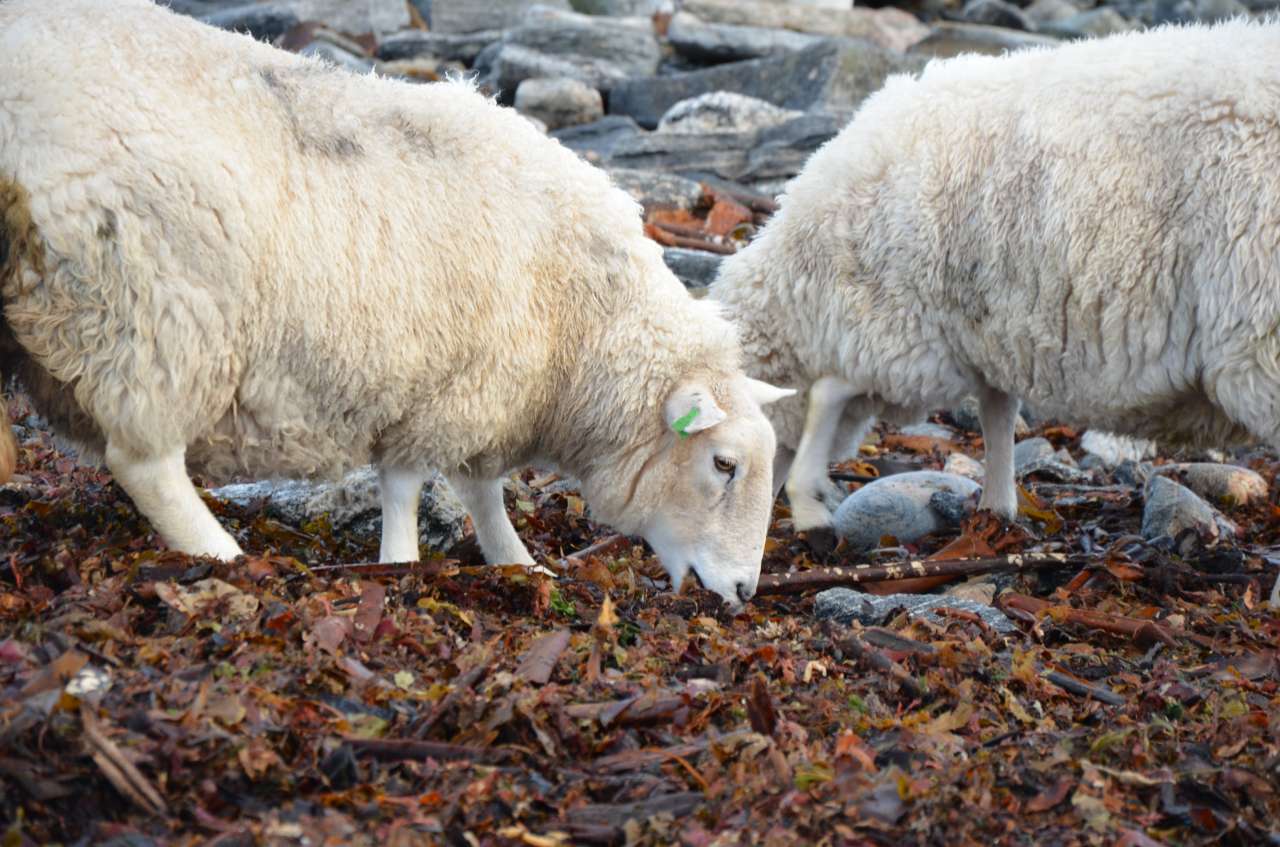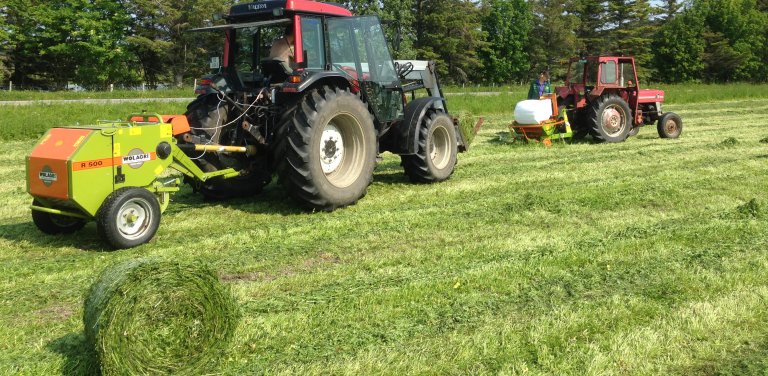Division of Food Production and Society
Legumes and seaweed as alternative protein sources for sheep

End: dec 2017
Start: jan 2014
Project participants
Margarita Novoa-Garrido Felix Heckendorn Ingrid Bay-Larsen Martin Riis Weisbjerg Eduarda Molina-Alcaide
| Status | Concluded |
| Start - end date | 01.01.2014 - 31.12.2017 |
| Project manager | Vibeke Lind |
| Division | Division of Food Production and Society |
| Department | Grassland and Livestock |
| Total budget | 7997000 |
Det viktigste resultatene prosjektet har kommet frem til, og som har fått mest fokus, er bruk av makroalger som en alternativ proteinkilde i fôr til drøvtyggere. I søknaden var det lagt vekt på også bruken av kvitkløver og tiriltunge. Kvitkløver ble testet ut som fôr med lovende resultat. Etablering av tiriltunge ble mer utfordrende enn test-produksjonen i forkant av søknaden visste, og vi kunne ikke gjennomføre forsøk med denne art. Alle de involverte institutter i søknaden, NIBIO og Nordlandsforskning i Norge, Aarhus Universitet i Danmark, FiBL i Sveits og CSIC i Spania, bidro til at prosjektet ble gjennomført på en god måte. Alle institutter hadde viktige oppgaver som hver for seg medførte aktivitet hos en av de andre. Prosjektet var knyttet sammen slik at alle måtte bidra for å lykkes.

Publications in the project
Authors
Vibeke Lind Martin Riis Weisbjerg Grete H. M. Jørgensen Julia E. Fernandez-Yepes Lesly Arbesú Eduarda Molina-AlcaideAbstract
No abstract has been registered
Authors
Vibeke LindAbstract
No abstract has been registered
Authors
Vibeke LindAbstract
No abstract has been registered
Abstract
No abstract has been registered
Authors
Charlotte Gaillard Hamzah Shahbaz Bhatti Margarita Novoa-Garrido Vibeke Lind Michael Roleda Martin Riis WeisbjergAbstract
The potential of seaweeds as alternative protein source was investigated in relation to their amino acid (AA) profiles and the ruminal and total tract digestibility of these AAs. Three red (Mastocarpus stellatus, Palmaria palmata, and Porphyra sp.), four brown (Alaria esculenta, Laminaria digitata, Pelvetia canaliculata, and Saccharina latissima), and two green (Cladophora rupestris. and Ulva sp.) seaweed species were used in this study (hereafter, referred to by Genus name only). All seaweeds were collected in Bodø, Northern Norway, during Spring and Autumn in 2014 and 2015, except Ulva, which was only sampled in Autumn of both years, and Saccharina which was not sampled in Spring 2014. All the samples were studied for AA concentration. Six species (Cladophora, Laminaria, Mastocarpus, Palmaria, Porphyra and Ulva) were selected for the more resource demanding in situ study. Species and season interactively affected the content of total AA in crude protein in different seaweeds investigated (P=0.02), with values ranging from 67.2 for Laminaria in Spring to 90.2 gAA/16 g N for Ulva in Autumn. in situ AA degradability was also species specific. The seasonality of total AA in crude protein of different seaweed species mostly did not affect their ruminal degradability, except for alanine, while species and season interactively affected proline’s ruminal degradability. The total tract degradability showed that for Laminaria and Mastocarpus, methionine followed by leucine, isoleucine, histidine and lysine, were protected against rumen degradation. These protections seemed to be acid labile allowing digestion in the lower digestive tract. However, due to high indigestible fractions, these two seaweeds provided low amounts of AA to the intestines. Total tract AA digestibility values were the highest for Porphyra (906 g/kg) followed by Palmaria (843 g/kg) and the green seaweeds. To conclude, Laminaria and Mastocarpus are beneficial sources for bypass protein supply as they contain AA protected against rumen degradation. Based on their amount of AA and their AA degradability, Porphyra, followed by Palmaria and the green seaweeds (Ulva and Cladophora) can be considered as relevant sources of protein for ruminants.
Authors
Martin Riis Weisbjerg Margarita Novoa Garrido Michael Roleda Eduarda Molina-Alcaide Vibeke LindAbstract
No abstract has been registered
Abstract
No abstract has been registered
Authors
Ingrid Agathe Bay-Larsen Ingebjørg Vestrum Vibeke Lind Camilla Risvoll Margarita Novoa Garrido Michael RoledaAbstract
No abstract has been registered
Abstract
The use of seaweeds in animal diets is not new. However, little is known about the feed value of seaweed, both in terms of chemical composition and protein digestibility, and regarding variation between species and season. In this study, eight seaweed species of the genus Acrosiphonia, Alaria, Laminaria, Mastocarpus, Palmaria, Pelvetia, Porphyra, and Ulva were sampled in spring (March) and autumn (October and November) 2014 at the coast of Bodø in Northern Norway, and were analysed for chemical composition, in situ rumen degradability and total tract crude protein (CP) digestibility. Ash content in dry matter (DM) was generally high (overall mean 190 g/kg in DM) and varied considerably, between species (P < 0.01) and between seasons (P = 0.02). CP concentration in DM varied both between species (P < 0.0001) and seasons (P < 0.01). Highest CP in DM was found for Porphyra (350 g/kg DM) and lowest for Pelvetia (90 g/kg DM). Spring samples were higher in CP than autumn samples. The effective degradability estimated at 5% rumen passage rate (ED5) of CP varied between species (P < 0.0001) but not between seasons (P = 0.10). The highest ED5 of CP was found for Alaria (550 g/kg CP) and lowest for Ulva (240 g/kg CP). Digestible rumen escape protein (DEP) varied significantly between species (P < 0.0001) but not between seasons (P = 0.06); highest DEP was found for Ulva (530 g/kg CP) and Porphyra (500 g/kg CP). Based on our results, Acrosiphonia, Alaria, Laminaria, Mastocarpus and Palmaria can supply the rumen with high amounts of rumen degradable protein, while Porphyra and Ulva can be used as a source of digestible bypass protein. Pelvetia had a very low degradability and should not be used to feed dairy cows.
Abstract
No abstract has been registered
Authors
Ingrid Agathe Bay-Larsen Ingebjørg Vestrum Vibeke Lind Camilla Risvoll Margarita Novoa Garrido Michael RoledaAbstract
No abstract has been registered
Abstract
No abstract has been registered
Authors
Steffen Werne Margarita Novoa-Garrido Martin Riis Weisbjerg Eduarda Molina-Alcaide Vibeke Lind Felix HeckendornAbstract
No abstract has been registered
Abstract
No abstract has been registered
Authors
Margarita Novoa-Garrido Lise Aanensen Vibeke Lind Hans Jørgen Larsen Søren Krogh Jensen Espen Govasmark Håvard SteinshamnAbstract
No abstract has been registered
